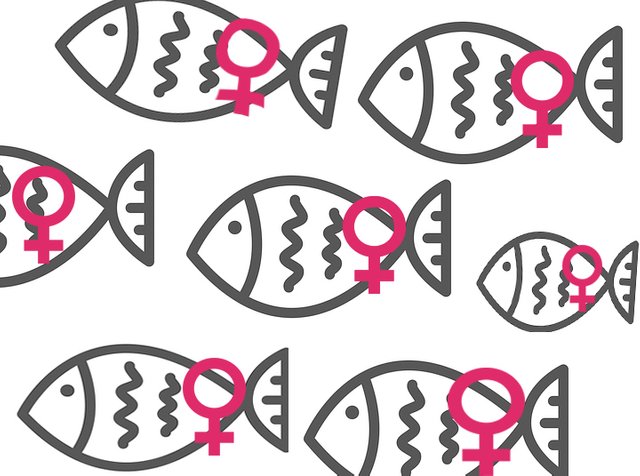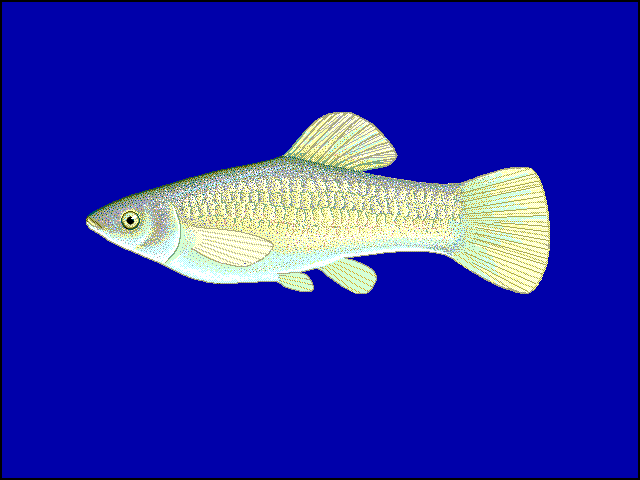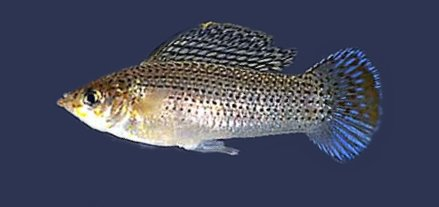The Amazon Molly - An All-Female Fish Species
Pretty much all of the animal species we are familiar with reproduce sexually with two genders - male and female. But as far as life goes, almost all rules have exceptions and there are always species that find a way to do something that would be unthinkable for others.

Such is the case with the Amazon molly (Poecilia formosa) which is a small freshwater fish species that does not include any male individuals and hasn't done so for tens of thousands of years. Interestingly enough, the species is not named after the river it lives in, but after the all-female Amazon warriors of Greek mythology. They are native to the warm fresh waters of the northern parts of Mexico and the southern parts of Texas in the USA.

All individuals from this species are female and they reproduce using a process called gynogenesis which is a form of parthenogenesis.
What is Parthenogenesis?
Parthenogenesis is a form of asexual reproduction in which the egg can develop without being fertilized. In this case, the offspring ends up being a direct clone of its parent. Since only female individuals can produce eggs, this mechanism can produce only female offspring as they inherit the genetically coded gender of their mother. If this is the only means of reproduction for a species, this means that the species will end up consisting of female individuals only.
There are different ways in which this process can occur and in the case of the Amazon molly, it actually requires the presence of a male.
What is Gynogenesis?
Gynogenesis is a form of parthenogenesis where in order for the egg to start dividing, it needs to be stimulated by a sperm cell. There is no transfer or recombination of genetic material, but for the egg to develop, it still needs to "feel" fertilized. The sperm cell is required to trigger the egg division so it can eventually develop into a full-grown individual. If there is no sperm to trigger the process, the females cannot reproduce. This means that while the females in the species are the only ones that pass on their genetic material to the next generation, they are not self-sufficient and cannot reproduce on their own.

But Where Do You Find a Male to Donate Sperm Cells in an All-Female Species?
Technically you don't - you borrow a male from a related species. And this is exactly what the Amazon molly does. Typically the females from the species mate with males from four other closely related species of molly: sailfin molly (Poecilia latipinna), shortfin molly (Poecilia mexicana), broadspotted molly (Poecilia latipunctata), and the common molly (Poecilia sphenops). Despite the fact that there is mating involved, the offspring do not inherit any genetic material from their fathers and there is no hybridization.

Interestingly enough, it's believed that the Amazon molly is a species that resulted from hybridization between two of the species that it currently prays upon for males - the sailfin molly and the shortfin molly. Data suggests that this happened 280,000 years ago.
Consequences
It's not entirely clear why the males from other species continue to mate with the Amazon molly females as this gives them no real evolutionary advantage and can be viewed as wasted effort, energy and viability. On top of this, it appears that the males are capable of telling the difference between their own species and the Amazon mollies, but still choose to mate with them. One theorized advantage for them might be that by doing so they become more attractive to the females of their own species, but whether this is the case remains unclear.
The Amazon molly benefits from an increased reproductive output as it does not need to produce males who do not give birth. This means that the potential reproductive output doubles every two generations. Additionally, the offspring are reasonably competitive as they are as adopted to their environment as their mother was. They can't adopt to changes in the environment or colonize new slightly different places, but they are still well-adopted to their current habitat.
When it shares a locality with another molly species, it's easy for it to start dominating as it not only reproduces more quickly, but it also takes up males from the competing species that do not end up reproducing as much. It's easy for this dynamic to run out of control and drive the other species of molly to a localized extinction. But as soon as their companion species disappears, the Amazon molly becomes unable to reproduce as well and disappears itself. This leads to locally unstable populations and regular local extinctions and repopulations.
Despite of this strange dynamic, the species still manages to thrive and has done so for almost 300 thousand years. This poses some intriguing questions as this mode of reproduction does not allow it to replenish or recombine its gene pool. This means that developing new adaptations becomes unlikely and harmful genetic changes might start propagating through the population as the gene pool becomes continuously shallower. Possibly, this little Amazon tribe has a few more tricks up its sleeve and can occasionally incorporate some genetic material from the species donating the sperm allowing some gene pool replenishment.
Whatever the case might be, the Amazon molly presents a curious case of one species depending on another for its reproduction and a whole species surviving with just one gender. This presents an opportunity to better study the evolutionary costs and benefits of sexual reproduction with two consistent genders and to better understand why it is so widespread.
Sources:
- https://en.wikipedia.org/wiki/Amazon_molly
- http://www.ensembl.info/blog/2014/04/28/sexual-parasitism-in-the-amazon-molly/
- https://nas.er.usgs.gov/queries/factsheet.aspx?SpeciesID=856/

Why is the presence of a male necessary?
I am confused; I thought this species of #Fish was an All Female contingent.
-- Oh, I see .. they mate (or "meet up with") the sailfin molly, the shortfin molly, the common molly & the broadspotted molly.
Hmmm, that's interesting. Learned something NEW today - thanx.
I Like your Profile name, btw -- 'Rocking Dave' ! ☻
I'm glad you found that interesting. I personally found that a fascinating evolutionary quirk.
I went through high school biology and as well as in med school and I understand this but gynogenesis is pretty weird. Just a trigger? That's just insane but cool too